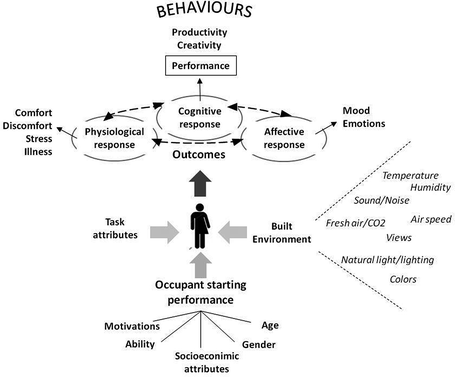“Whatever good things we build end up building us.” – Jim Rohn
An Overview:
The interplay of architecture and human psychology is vital; people dwell into the varied built and unbuilt environment in their habitual life. The places where we think, learn, work, play and live acts as a stage – a backdrop of the screenplay in our lives. There is a reciprocal relationship between a person responds to the surrounding environment and the influence of environment over one’s behaviour. Anthropological, sociological and psychological researches have made a mystery of human behavior effortless for designers.

Relationship of Architecture and Human Behavior
The needs of humans are expansive and ever-changing, understanding the concepts of preferences, cognition and space adaptation are the vital factors evolving the design of the built environment to correspond with human behaviour. The interface of human-architecture influences positively or negatively on human senses and function to different stimuli. “Buildings and cities directly effect on human’s behaviour. They can be depressing or uplifting, soothing or surprising, welcoming or forgiving.”
Architecture is said to be “the third skin to the human body,” since the skin is the first skin acting as outer and envelope to the body, clothes acting as the second skin for insulation and filter, therefore the space within people reside – acts as “third skin.” The personality of the inhabitants depends on the shape and architecture of the building. Each building has different functions, hence there’s an imperative to use the building creating optimal mood, desire, security and sense of coherence.

Architecture started as a means of protection and shelter from our surrounding environment, gradually evolved as an art form into which subjectivity, creativity and aesthetics were introduced. Currently, this artform form is again being evolved to a subject of psychological study and well-being. Urban structures and cities influence humans in many ways. Its is true whether the environment is natural or manmade, understanding the way it affects people could enable design, construction of work and recreation spaces.
Perception of humans towards Built environment
Human behaviour refers to physical as well as mental psychology that engages humans biologically, socially, intellectually, etc. Factors that affect human behaviour include:
- Personality
- Human Senses
- Perception
- Social Culture and Tradition
What architects create is a potential environment and what a person uses is his or her effective environment. The design reflects the client’s or inhabitant’s personality via materials, forms and façade. Based on personality, psychology and past events, many types of architecture evolved like brutalist, genetic, religious, climate-responsive, etc.

Five senses are receivers and gateways to the human mind. They enable us to sense the world around us. Our eyes see it, our ears hear it, our nose smells, our mouth tastes it, and our touch feels it. Similarly, when we enter any space we start noticing, recognizing, visualizing and evaluating through all our senses. Thus, the surrounding environment affects massively on user’s mental and physical behaviour. The visual sense enables light and colour stimulus to change our mood and emotion. The auditory sense gives a therapy to mind and body to act and behave according to the sound wave.
From alarm clocks buzzing in the morning to the last blink in the night, an adult spends 70-80% of their time in a built environment, and space, lighting, colours, acoustics and aesthetics indeed play a crucial role on the behaviour of an individual. So ever thought of, what actually shapes our personality? Individual differences bound to exist such a proper architectural implementation to meet everyone’s perception and desires is essential. Perseverance of space is utmost important while designing a space to comfort the user in the surrounding environment at ease – be it a public space or our own home. For instance, a prison cannot be bright and with vibrant colours as it is not meant to be. Whereas, a nursing home needs to be soothing and calm for the senior citizens to feel like a home and lively. This responsibility is looked forward by architects that can communicate with its users.
Conclusion:
What a user does and why the thoughts and feelings that accompany actions are somehow linked to the designed environment. Architects need to pay special concern towards design. If individuals lose their perception of the environment and the criterion for judging it, architecture will not have an achievement. Architecture is a direct response to expectations. If architects collaborate to psychologists to direct their design and meet aspects of human needs such as survival, safety, belonging, appreciation, learning and beauty. The close relationship between architects and psychologists can lead to a reduction in current stress and tensions, making the built environment a better place to live in.




